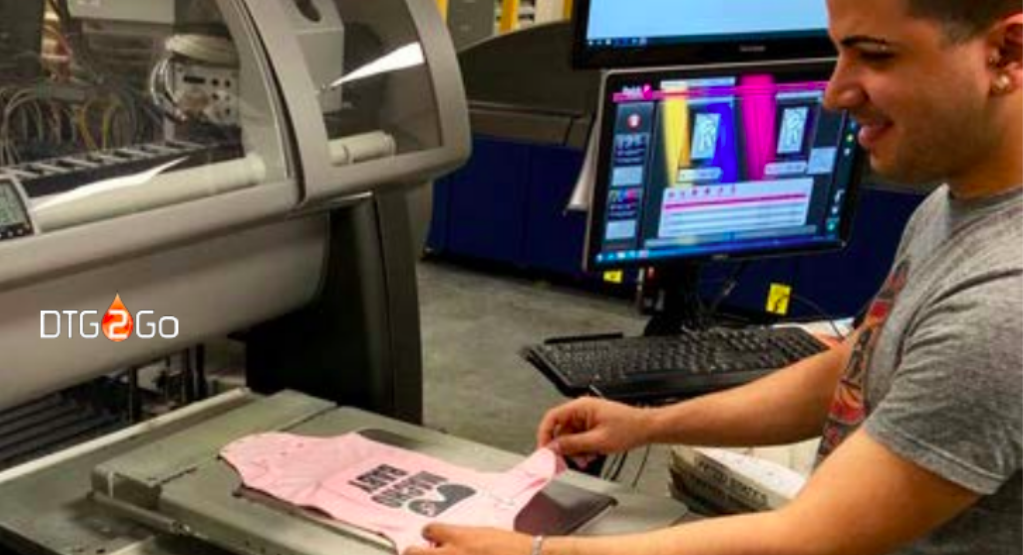Speaking at the 31st Annual ROTH Conference, officials at Delta Apparel Inc. said DTG2Go, its digital print and fulfillment business, is poised to expand at a 20 percent CAGR (compound annual growth rate) in the years ahead with digital screen-printing just starting to take off.
The business is also the most profitable business for Delta with double-digit operating profits at more than 20 percent EBITDA margins.
Bob Humphreys, chairman and CEO, said Delta first got into the digital screen-print business with the acquisition in fiscal 2010 of a start-up, Art Gun. With further investments, Art Gun within two years became the leading player in the digital print space and sales nearly doubled to $27 million in fiscal 2018 with the acquisition of the second-largest player, DTG2Go. The name of the business changed from Art Gun to DTG2Go after the acquisition.
With continued organic growth and the acquisition of the third-largest player, SSI Digital Print, last October, sales are projected to reach $50 million in fiscal 2019.
But Deb Merrill, CFO, said the business has just started to tap its growth potential with digital still representing less than 5 percent of all graphic impressions globally. Said Merrill, “With 2 or 3 billion graphic impressions on tees just sold in the U.S., you can imagine the growth opportunity we see here.”
Indeed, DTG2Go has largely found growth through e-tailers that see the benefits by not having to stock inventory until they sell the product. Digital print is moving “very quickly” into the larger promotional product space as those customers also appreciate digital’s customization capabilities and small-print runs. Screenprinters also appreciated the ability to small-print runs of high-color counts that tend to be expensive to do through screen-printing.
DTG2Go is also working with an unnamed national retailer looking to take advantage of being able to offer more graphics online. Digital also supports in-store replenishment quickly and customers can order graphics online if it’s unavailable in the store.
Technology will also advance capabilities for DTG2Go. DTG2Go became the first company to use the Kornit ATLAS, which prints 80 percent more per hour than current AVK 1000. The machine also utilizes a new ‘odor-less’ pre-spray for a higher-quality product. DTG2Go is also the only company beta-testing the first high-quality polyester and polyblend digital printer, also from Kornit.
Speed to market is also a focus for DTG2Go. The business currently has five distribution centers but that will expand to seven this year. The expansion will enable DTG2Go to support lower delivery costs also reach 99 percent of the U.S. population in one or two days with 50 percent in one day.
Among its other businesses, Delta Activewear continues to be the company’s largest business, representing 60 percent of sales. Delta Activewear has grown from about $110 million when Delta Apparel was spun off from Delta Woodside to $275 million. The business is seeing a steady 5 percent compounded annual growth and solid profitability with a 10 percent EBITDA margin.
Said Humphreys, “We think Delta Activewear will continue to gain market share. We have a different go-to-market strategy where we’re selling deeper into the supply chain and providing a higher level of service and that’s resonating with our customers and bringing additional business to us.”
A particular focus for the Delta Activewear segment has been shifting away from core basics toward private label items and fashion basics that have higher-quality materials and fashion-forward styling to offer a higher margin. From fiscal 2016 through fiscal 2018, core basics sales declined at a CAGR of 4 percent to $137 million from $150 million while the private label business has grown at a 6 percent CAGR to $109 million from $98 million. Fashion basics, led by the Delta Platinum label, has expanded at a 63 percent CAGR over that period to $37 million from $14 million.
The Delta Activewear segment is continuing to benefit from its fully-vertical manufacturing and distribution platform. Products are made in factories in Central America and Mexico and delivered from seven distribution centers across the country. Merrill said the vertical approach enables customers to receive goods directly and at piece level. Many competitors only offer larger quantities such as case or truck-load levels.
Salt Life, a lifestyle brand focused on ocean adventures, is also poised for double-digit growth. The brand started in Jacksonville Beach, FL as a men’s brand and men’s on a direct-to-consumer basis still accounts for the majority of sales, at 60 percent. But women’s apparel, accounting for 20 percent of DTC sales, and kids, accounting for 5 percent, have been expanding at a faster rate and that’s expected to continue. Accessories, including optics that were recently brought in-house, make up 15 percent of the DTC mix.
Salt Life benefits from its large following across social media, including 1.1 million followers on Facebook and 66,000 videos on YouTube. A big branding benefit has come from the sale of over two million Salt Life decals that often wind up on fan’s vehicles. Salt Life also has brand ambassadors in the fishing and surfing space.
Salt Life currently has five stores and plans to open two to three a year. Other growth opportunities for Salt Life include the launch of a swim line this spring and Salt Life beer that’s expected to reach five states (Florida, Georgia, Alabama, North Carolina and South Carolina) by year-end.
Online also offers opportunities for growth for both Salt Life and the Soffe activewear brand. Combined, the two brands saw e-commerce sales expand 11 percent to $5.1 million in fiscal 2018 and is another 15 percent in its fiscal first quarter. Both brands are seeing faster growth through B-to-B online sites, expanding 21 percent in fiscal 2018 to $20.1 million combined and running up 30 percent in Delta’s fiscal first quarter.
Image courtesy DTG2Go
















